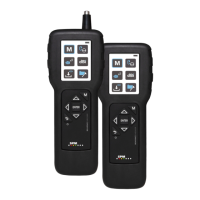28
A) Maximum value dBm
B) Difference between dBm and dBc
C) Rhythm of the strongest pulses
A shock pulse pattern is a sequence of either random
or rhythmical strong pulses (dBm level) above a carpet
of very rapid weaker pulses (dBc level). You have to be
aware of:
• the dBm value
• the difference between dBm and dBc
• the rhythm of the strongest pulses.
The rhythm of the strongest pulses is best discerned by
listening with the headphone at a setting a few dB below
the dBm level. Typical for bearing signals is a random
sequence of strong pulses (no discernable rhythm). Rhyth-
mical shocks can come from a bearing but are more often
a sign of interference. Typical patterns are described on
the next pages.
The BearingChecker recognizes the pattern of the read-
ing taken and determines which of the six patterns below
is a match. The matching number is displayed in the
condition evaluation part of the Measurement display
(A) when the measurement is completed and you scroll
with the DOWN arrow key. This number corresponds to
the pattern numbers below.
There may be times when the instrument displays a
combination of the numbers “2/3” or “4/5”, in which
case the instrument can not distinguish between the two
codes. Use the headphones and listen to the pattern to
determine condition code.
1 Pattern from a good bearing
A bearing in good condition should have a dBm value
below 20 and a dBc value approximately 5 to 10 dB lower.
Once you have verified the reading, there is no need for
any further evaluation.
The maximum value can be lower than 0. However, be
suspicious when the measured value is very low. The
cause is often a bad measuring point or an incorrectly
installed adapter or transducer. If the reading is very low,
check the installation. Measure on other parts of the bear-
ing housing and try to pick up a stronger signal. Another
possible reason for a very low reading is that there is no
load on the bearing. This can happen with well balanced
fans and similar rotating machines.
Typical shock pulse patterns from rolling bearings
A
B
C
dBm
dBc
Measurement
A

